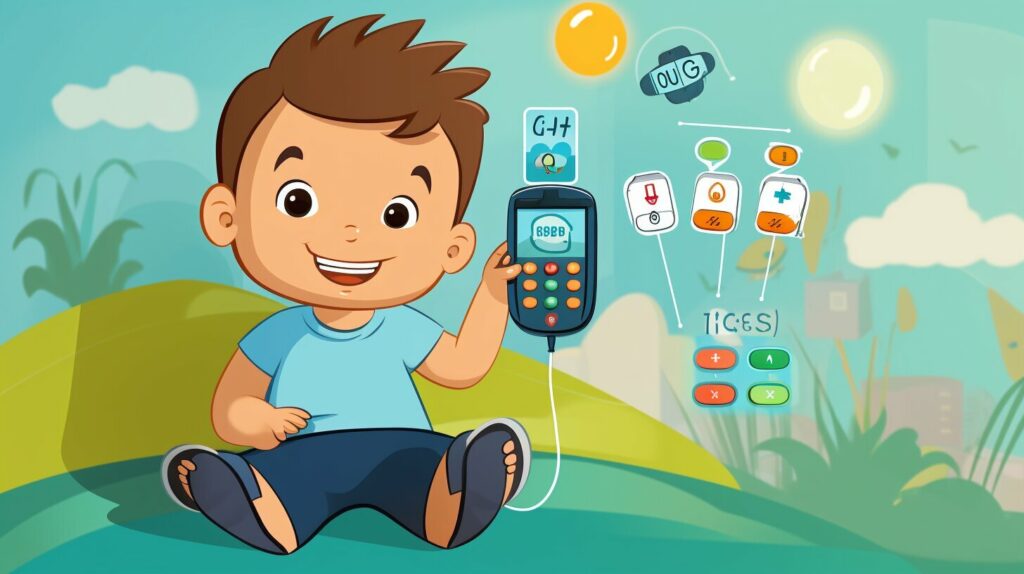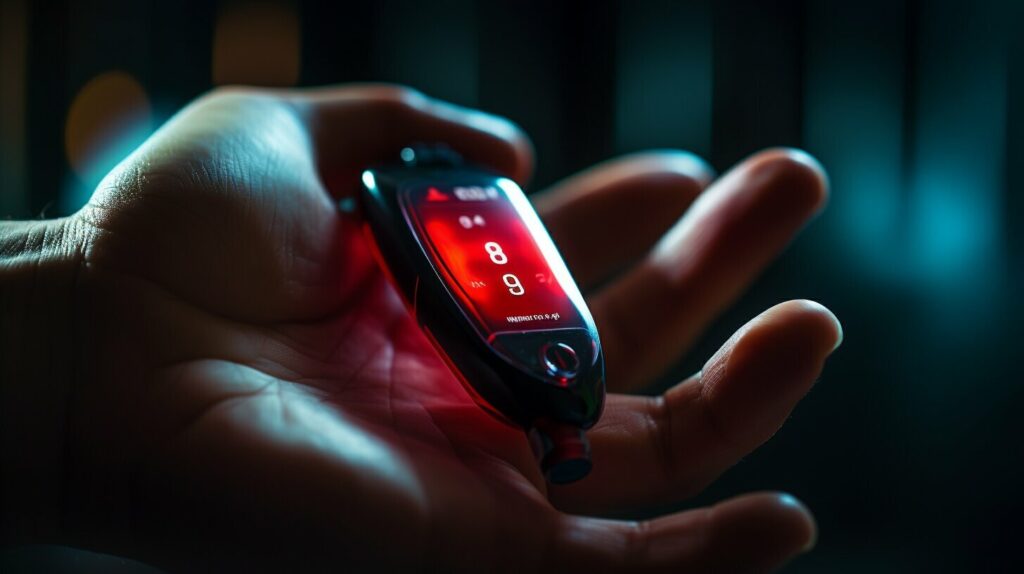It can be challenging to explain a complex medical condition like diabetes to a child. However, providing them with age-appropriate information can help to demystify the condition and empower them to manage their health.
By following these simple and clear steps, you can help your child understand diabetes and how it affects their body.
Key Takeaways:
- Explain diabetes in simple terms appropriate for your child’s age.
- Discuss the different types of diabetes and their causes.
What is Diabetes?
Diabetes is a condition that affects the way your body processes glucose, a form of sugar that provides energy for your body. When you eat, your body breaks down food into glucose which is then transported to your cells for energy. However, in people with diabetes, the glucose stays in the bloodstream instead of being used by the cells for energy.
There are two main types of diabetes: type 1 and type 2. Type 1 diabetes is an autoimmune disease that occurs when the body’s immune system attacks and destroys the cells in the pancreas that produce insulin. Insulin is a hormone that helps regulate blood sugar levels. Without insulin, the body cannot process glucose properly, and the glucose builds up in the bloodstream.
Type 2 diabetes occurs when the body becomes resistant to insulin or doesn’t produce enough insulin to process glucose properly. This type of diabetes is often linked to lifestyle factors such as being overweight, having a poor diet, and being physically inactive.

It’s important to note that while both types of diabetes have similar symptoms and complications, they have different causes and treatments. Your doctor can help determine which type of diabetes you have through a series of tests.
How Does Diabetes Affect the Body?
Diabetes affects the body’s ability to regulate blood sugar levels. When we eat food, our body breaks it down into glucose, which is a type of sugar that the body uses for energy. The hormone insulin, produced in the pancreas, helps move glucose from the bloodstream into cells to be used for energy.
However, in people with diabetes, this process doesn’t work as it should. In Type 1 diabetes, the body doesn’t produce enough insulin, while in Type 2 diabetes, the body doesn’t respond to insulin as effectively as it should. As a result, glucose builds up in the bloodstream and can’t be used for energy.
This can cause a range of health problems over time, including damage to the eyes, kidneys, nerves, and blood vessels. High blood sugar levels can also increase the risk of heart disease, stroke, and other serious conditions.
It’s important to monitor blood sugar levels regularly and follow a healthcare provider’s recommendations for managing diabetes to help prevent these complications and lead a healthy, active life.

Signs and Symptoms of Diabetes
It’s important to be aware of the signs and symptoms of diabetes so you can seek medical attention if you or someone you know experiences them. Some common symptoms include:
- Frequent urination
- Excessive thirst
- Unexplained weight loss
- Fatigue
If your child experiences any of these symptoms, it’s important to see a doctor as soon as possible. Early diagnosis and treatment can help prevent complications and improve long-term health outcomes.
Image source: 
Managing Diabetes
It’s important for your child to understand that managing diabetes is an ongoing process that requires making healthy lifestyle choices. This includes eating a balanced diet, getting regular exercise, and taking medication or insulin injections as directed by their doctor. By keeping their blood sugar levels within a healthy range, they can avoid complications and lead a full and active life.
Encourage your child to be involved in their diabetes management plan. This can include helping plan meals, tracking their blood sugar levels, and reminding them to take their medication. It’s also important for them to communicate with their doctor and ask any questions they may have about their condition.
Remember to provide emotional support and positive reinforcement to your child as they navigate their journey with diabetes. By working together, you can help them develop the skills and confidence to manage their condition and live a healthy, fulfilling life.

Blood Sugar Monitoring
Monitoring your blood sugar is an important part of managing diabetes. By checking your blood sugar levels regularly, you can make informed decisions about food, exercise, and medication.
Using a glucose meter is a common way to check blood sugar levels. To do so, you will need to:
| Step | Instructions |
|---|---|
| Step 1 | Wash your hands with soap and warm water. Dry them well. |
| Step 2 | Insert a test strip into your glucose meter. |
| Step 3 | Prick the side of your fingertip with a lancet to get a drop of blood. |
| Step 4 | Touch and hold the edge of the test strip to the drop of blood. The meter will display your blood sugar result. |
It’s important to check your blood sugar level regularly at the times recommended by your healthcare provider. They may recommend checking before and after meals, before and after physical activity, and at bedtime.

Remember, if you check your blood sugar and it’s too high or too low, take action as instructed by your healthcare provider. By monitoring your blood sugar and taking appropriate steps, you can help manage your diabetes and stay healthy!
Dealing with High and Low Blood Sugar
Now that you know about blood sugar levels, let’s talk about what happens when they get too high or too low. This is called hyperglycemia or hypoglycemia.
Hyperglycemia happens when there is too much sugar in your blood. This can make you feel thirsty, tired, and need to go to the bathroom more often. If you have high blood sugar, it’s important to take your medication or insulin as directed by your doctor, and drink plenty of water. If your blood sugar is very high, you may need to see a doctor or go to the emergency room.
| Signs of hyperglycemia: | What to do: |
|---|---|
| Frequent urination | Drink plenty of water and take medication or insulin as directed by your doctor. |
| Increased thirst | Monitor your blood sugar levels regularly. |
| Fatigue | Call your doctor or seek medical attention if your blood sugar remains high or if you experience any other symptoms. |
Hypoglycemia happens when there is too little sugar in your blood. This can make you feel shaky, dizzy, confused, or even pass out. If your blood sugar is too low, you need to eat or drink something with sugar right away. This could be fruit juice, candy, or glucose tablets. Check your blood sugar levels regularly and always carry glucose tablets or snacks with you in case of an emergency.
| Signs of hypoglycemia: | What to do: |
|---|---|
| Shakiness | Eat or drink something with sugar, like fruit juice or candy. |
| Dizziness | Monitor your blood sugar levels regularly. |
| Confusion | Seek medical attention immediately if you experience severe symptoms or if your blood sugar remains low. |
Remember to always tell a trusted adult if you feel unwell or experience any symptoms of high or low blood sugar.

Diabetes and Everyday Life
Living with diabetes may require some adjustments to your daily routine, but it doesn’t mean you can’t enjoy an active and fulfilling life. By making healthy choices and staying on top of your diabetes management, you can feel your best and pursue your passions.
When it comes to meal planning, aim for a balanced diet rich in whole grains, lean proteins, and plenty of fruits and vegetables. Work with your healthcare team to determine the appropriate number of carbohydrates for each meal and snack, and consider using a food tracker app to monitor your intake.
Regular physical activity is also important for managing diabetes. Encourage your child to participate in activities they enjoy, such as sports or dance classes. Work with their doctor to determine the best time to exercise and how to adjust medication or insulin doses accordingly.
It’s also important to inform teachers, coaches, and friends about your child’s diabetes. Provide detailed instructions on how to recognize and respond to high and low blood sugar levels, and make sure they have access to fast-acting sources of sugar in case of an emergency.
Remember, your child may face some challenges along the way, but with your support and encouragement, they can thrive with diabetes. Stay positive, stay informed, and never be afraid to reach out for help when you need it.

Conclusion
Congratulations! You have taken an important step in helping your child understand diabetes. By providing age-appropriate information and using accessible language, you can empower your child with knowledge about this condition. Remember to address any concerns they may have and encourage ongoing communication.
Managing diabetes can be challenging, but with the right tools and support, your child can live a happy and healthy life. Continue to educate yourself and your child about this condition, and don’t hesitate to reach out to healthcare professionals for guidance. Together, you can navigate and overcome any obstacles that may arise.
Can I Use Similar Steps to Explain Conjecture to a Child?
Explaining math concepts to children can be challenging, especially when it comes to complex topics such as conjecture. So, what is a conjecture in math? In simple terms, it is an educated guess or prediction based on observations and patterns. By breaking it down step by step using relatable examples, we can help children grasp the concept of conjecture and develop their logical thinking skills.
FAQ
Q: How do I explain diabetes to a child in a simple and clear manner?
A: Start by providing age-appropriate information and using accessible language. Explain what diabetes is and how it affects the body using simple terms that your child can understand.
Q: What is diabetes?
A: Diabetes is a condition that affects the body’s ability to regulate blood sugar levels. There are different types of diabetes, such as Type 1 and Type 2, each with its own causes.
Q: How does diabetes affect the body?
A: Diabetes affects the body’s ability to use glucose for energy. Insulin, a hormone produced by the body, helps move glucose into cells. In diabetes, there is either a lack of insulin or the body’s cells do not respond properly to insulin.
Q: What are the signs and symptoms of diabetes?
A: Common signs and symptoms of diabetes include frequent urination, excessive thirst, unexplained weight loss, and fatigue. It is important to seek medical attention if you or someone you know experiences these symptoms.
Q: How can diabetes be managed?
A: Diabetes can be managed through healthy lifestyle choices, such as maintaining a balanced diet, engaging in regular exercise, and taking medication or insulin injections as prescribed.
Q: Why is blood sugar monitoring important?
A: Regular blood sugar monitoring helps manage diabetes by providing information about your child’s blood sugar levels. This information can help make informed decisions about food, exercise, and medication.
Q: What should I do if my child has high or low blood sugar?
A: If your child has high blood sugar, they may need insulin or medication. If they have low blood sugar, they should consume a fast-acting source of sugar, such as juice or candy. It is important to notify a trusted adult if they experience these symptoms.
Q: How does diabetes impact everyday life?
A: Diabetes may require meal planning, regular physical activity, and adjustments to school routines. It is important to inform teachers, coaches, and friends about your child’s condition. With proper management, your child can still participate in activities they enjoy.
Q: What should I remember about explaining diabetes to a child?
A: Summarize the key points discussed and emphasize the importance of empowering your child with knowledge about diabetes. Encourage open communication and ongoing support as they navigate their journey with diabetes.






